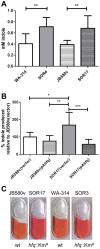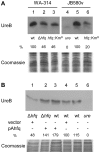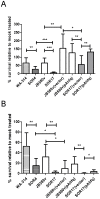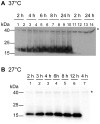The RNA chaperone Hfq impacts growth, metabolism and production of virulence factors in Yersinia enterocolitica
- PMID: 24454955
- PMCID: PMC3893282
- DOI: 10.1371/journal.pone.0086113
The RNA chaperone Hfq impacts growth, metabolism and production of virulence factors in Yersinia enterocolitica
Abstract
To adapt to changes in environmental conditions, bacteria regulate their gene expression at the transcriptional but also at the post-transcriptional level, e.g. by small RNAs (sRNAs) which modulate mRNA stability and translation. The conserved RNA chaperone Hfq mediates the interaction of many sRNAs with their target mRNAs, thereby playing a global role in fine-tuning protein production. In this study, we investigated the significance of Hfq for the enteropathogen Yersina enterocolitica serotype O:8. Hfq facilitated optimal growth in complex and minimal media. Our comparative protein analysis of parental and hfq-negative strains suggested that Hfq promotes lipid metabolism and transport, cell redox homeostasis, mRNA translation and ATP synthesis, and negatively affects carbon and nitrogen metabolism, transport of siderophore and peptides and tRNA synthesis. Accordingly, biochemical tests indicated that Hfq represses ornithine decarboxylase activity, indole production and utilization of glucose, mannitol, inositol and 1,2-propanediol. Moreover, Hfq repressed production of the siderophore yersiniabactin and its outer membrane receptor FyuA. In contrast, hfq mutants exhibited reduced urease production. Finally, strains lacking hfq were more susceptible to acidic pH and oxidative stress. Unlike previous reports in other Gram-negative bacteria, Hfq was dispensable for type III secretion encoded by the virulence plasmid. Using a chromosomally encoded FLAG-tagged Hfq, we observed increased production of Hfq-FLAG in late exponential and stationary phases. Overall, Hfq has a profound effect on metabolism, resistance to stress and modulates the production of two virulence factors in Y. enterocolitica, namely urease and yersiniabactin.
Conflict of interest statement
Figures









Similar articles
-
Interplay between the RNA Chaperone Hfq, Small RNAs and Transcriptional Regulator OmpR Modulates Iron Homeostasis in the Enteropathogen Yersinia enterocolitica.Int J Mol Sci. 2023 Jul 6;24(13):11157. doi: 10.3390/ijms241311157. Int J Mol Sci. 2023. PMID: 37446335 Free PMC article.
-
The RNA Chaperone Hfq Is Essential for Virulence and Modulates the Expression of Four Adhesins in Yersinia enterocolitica.Sci Rep. 2016 Jul 8;6:29275. doi: 10.1038/srep29275. Sci Rep. 2016. PMID: 27387855 Free PMC article.
-
Several Hfq-dependent alterations in physiology of Yersinia enterocolitica O:3 are mediated by derepression of the transcriptional regulator RovM.Mol Microbiol. 2017 Mar;103(6):1065-1091. doi: 10.1111/mmi.13610. Epub 2017 Jan 23. Mol Microbiol. 2017. PMID: 28010054
-
Hfq: a multifaceted RNA chaperone involved in virulence.Future Microbiol. 2016;11(1):137-51. doi: 10.2217/fmb.15.128. Epub 2015 Dec 18. Future Microbiol. 2016. PMID: 26685037 Review.
-
Hunger for iron: the alternative siderophore iron scavenging systems in highly virulent Yersinia.Front Cell Infect Microbiol. 2012 Nov 30;2:151. doi: 10.3389/fcimb.2012.00151. eCollection 2012. Front Cell Infect Microbiol. 2012. PMID: 23226687 Free PMC article. Review.
Cited by
-
The small RNA RssR regulates myo-inositol degradation by Salmonella enterica.Sci Rep. 2018 Dec 10;8(1):17739. doi: 10.1038/s41598-018-35784-8. Sci Rep. 2018. PMID: 30531898 Free PMC article.
-
Interplay between the RNA Chaperone Hfq, Small RNAs and Transcriptional Regulator OmpR Modulates Iron Homeostasis in the Enteropathogen Yersinia enterocolitica.Int J Mol Sci. 2023 Jul 6;24(13):11157. doi: 10.3390/ijms241311157. Int J Mol Sci. 2023. PMID: 37446335 Free PMC article.
-
Enteropathogens: Tuning Their Gene Expression for Hassle-Free Survival.Front Microbiol. 2019 Jan 9;9:3303. doi: 10.3389/fmicb.2018.03303. eCollection 2018. Front Microbiol. 2019. PMID: 30687282 Free PMC article. Review.
-
The Multiple Regulatory Relationship Between RNA-Chaperone Hfq and the Second Messenger c-di-GMP.Front Microbiol. 2021 Jul 14;12:689619. doi: 10.3389/fmicb.2021.689619. eCollection 2021. Front Microbiol. 2021. PMID: 34335515 Free PMC article. Review.
-
Urease Expression in Pathogenic Yersinia enterocolitica Strains of Bio-Serotypes 2/O:9 and 1B/O:8 Is Differentially Regulated by the OmpR Regulator.Front Microbiol. 2020 Apr 8;11:607. doi: 10.3389/fmicb.2020.00607. eCollection 2020. Front Microbiol. 2020. PMID: 32322248 Free PMC article.
References
-
- Autenrieth IB, Firsching R (1996) Penetration of M cells and destruction of Peyer's patches by Y ersinia enterocolitica: an ultrastructural and histological study. J Med Microbiol 44: 285–294. - PubMed
Publication types
MeSH terms
Substances
LinkOut - more resources
Full Text Sources
Other Literature Sources

